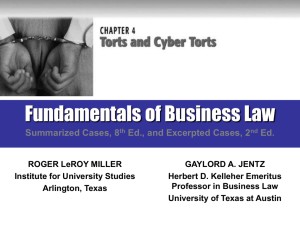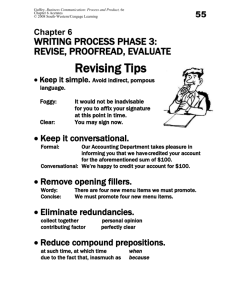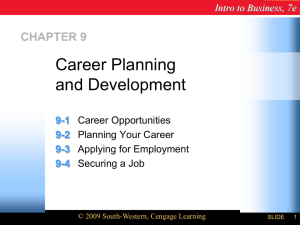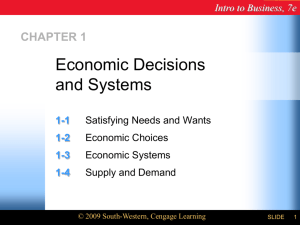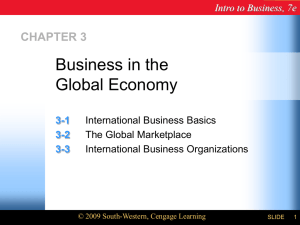Economic Decisions and Systems
advertisement
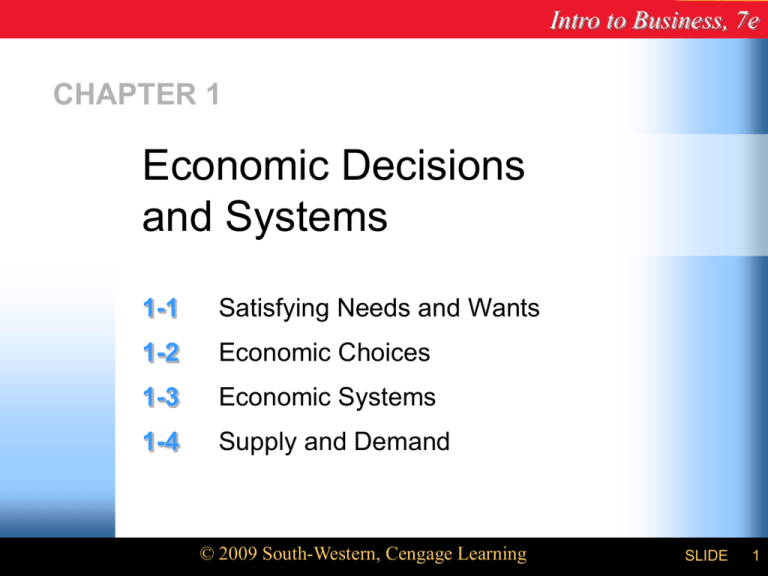
Intro to Business, 7e CHAPTER 1 Economic Decisions and Systems 1-1 Satisfying Needs and Wants 1-2 Economic Choices 1-3 Economic Systems 1-4 Supply and Demand © 2009 South-Western, Cengage Learning SLIDE 1 Intro to Business, 7e 1-1 Satisfying Needs and Wants Learning Target: Students will be able to: Explain the difference between needs and wants. Distinguish between goods and services. Describe the types of economic resources. © 2009 South-Western, Cengage Learning SLIDE 2 Intro to Business, 7e Chapter 1 NEEDS AND WANTS Needs are essential Wants add to the quality of life Needs and wants are unlimited © 2009 South-Western, Cengage Learning SLIDE 3 Intro to Business, 7e Chapter 1 ECONOMIC RESOURCES Natural: water, land, trees, animals, and minerals. Human: labor (people who run farms and factories, transport goods, provide services, or manage businesses). Capital: money, land, buildings, tools, and equipment © 2009 South-Western, Cengage Learning SLIDE 4 Intro to Business, 7e 1-2 Economic Choices Learning Target Students will: Understand the basic economic problem. Explain the steps in the decision-making process. © 2009 South-Western, Cengage Learning SLIDE 5 Intro to Business, 7e Chapter 1 THE DECISION-MAKING PROCESS 1. Define the problem. 2. Identify the choices. 3. Evaluate the advantages and disadvantages of each choice. 4. Choose one. 5. Act on your choice. 6. Review your decision. © 2009 South-Western, Cengage Learning SLIDE 6 Intro to Business, 7e 1-3 Economic Systems Learning Target Students will be able to: Identify the three economic questions. Differentiate among the main types of economic systems. Describe the economic system of the United States. © 2009 South-Western, Cengage Learning SLIDE 7 Intro to Business, 7e Chapter 1 THE THREE ECONOMIC QUESTIONS What to produce? How to produce? What needs and wants to satisfy? A nation’s plan for answering these three questions is called it’s economic system. © 2009 South-Western, Cengage Learning SLIDE 8 Intro to Business, 7e Chapter 1 TYPES OF ECONOMIC SYSTEMS Command economy – resources are owned and controlled by the government Market economy – resources are owned and controlled by the people Traditional economy – good & services produced the same; less developed countries Mixed economies – combines elements of command and market economy © 2009 South-Western, Cengage Learning SLIDE 9 Intro to Business, 7e Chapter 1 THE U.S. ECONOMIC SYSTEM Four principles of the U.S. economic system: Private property Freedom of choice Profit Competition © 2009 South-Western, Cengage Learning SLIDE 10 Intro to Business, 7e 1-4 Supply and Demand Learning Target Students will be able to: Describe supply and demand. Discuss how supply and demand affect prices of products and services. © 2009 South-Western, Cengage Learning SLIDE 11 Intro to Business, 7e Chapter 1 PARTICIPATING IN A MARKET ECONOMY Consumers set demand Producers establish supply © 2009 South-Western, Cengage Learning SLIDE 12 Intro to Business, 7e Chapter 1 Checkpoint >> How does the price of a product affect demand and supply? Answer As prices decrease, the number of consumers willing and able to purchase the product will increase and demand will rise. As prices increase, the number of consumers willing and able to purchase the product will decrease and demand will decrease. © 2009 South-Western, Cengage Learning SLIDE 13


